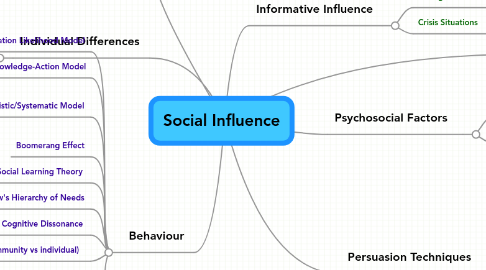Social Influence
by Karen Cirovski


1. Normative Influence
1.1. Collectivist Countries
1.2. Individualistic Countries
1.3. Conformity (group norms)
1.4. Rejection
2. Individual Differences
2.1. Attitude vs Content
2.2. Repetition: polarisation of initial response
2.3. Self-esteem
2.4. Cognition/Effortful Thinking
2.5. Personal Relevance
2.6. Knowledge
2.7. Intelligence
3. Behaviour
3.1. Elaboration Likelihood Model
3.2. Knowledge-Action Model
3.3. Heuristic/Systematic Model
3.3.1. Conscious Processing
3.3.1.1. Central Route/Systematic Processing
3.3.2. Automatic Processing
3.3.2.1. Peripheral Route/Heuristic
3.4. Boomerang Effect
3.5. Social Learning Theory
3.6. Maslow's Hierarchy of Needs
3.7. Cognitive Dissonance
3.8. Diffusion of Innovations (community vs individual)
3.9. Health
3.9.1. Health Belief Model
3.9.2. Theory of Planned Behaviour
3.9.3. Transtheoretical Model
3.9.4. Psychosocial Health
3.9.4.1. Emotional (Feeling)
3.9.4.2. Spiritual (Being)
3.9.4.3. Mental (Thinking)
3.9.4.4. Social (Relating)
4. Informative Influence
4.1. Ambiguous Situations
4.2. Crisis Situations
5. Social Influence Techniques
5.1. Foot-in-the-Door
5.2. Low Ball
5.3. Bait and Switch
5.4. Labeling
5.5. Legitimization-of-Paltry-Favours
5.6. Door-in-the-Face
5.7. That's-Not-All
5.8. Scarcity Principle
5.9. Psychological Reactance
5.10. Fast-Approaching-Deadline
5.11. Limited Number
5.12. Pique
5.13. Disrupt-Then-Reframe
6. Persuasion Techniques
6.1. Sleeper Effect
6.2. Source Credibility
6.2.1. Expertise
6.2.2. Trustworthiness
6.2.2.1. Convert Communicators
6.2.3. Fast Talkers
6.2.4. Powerful Speakers
